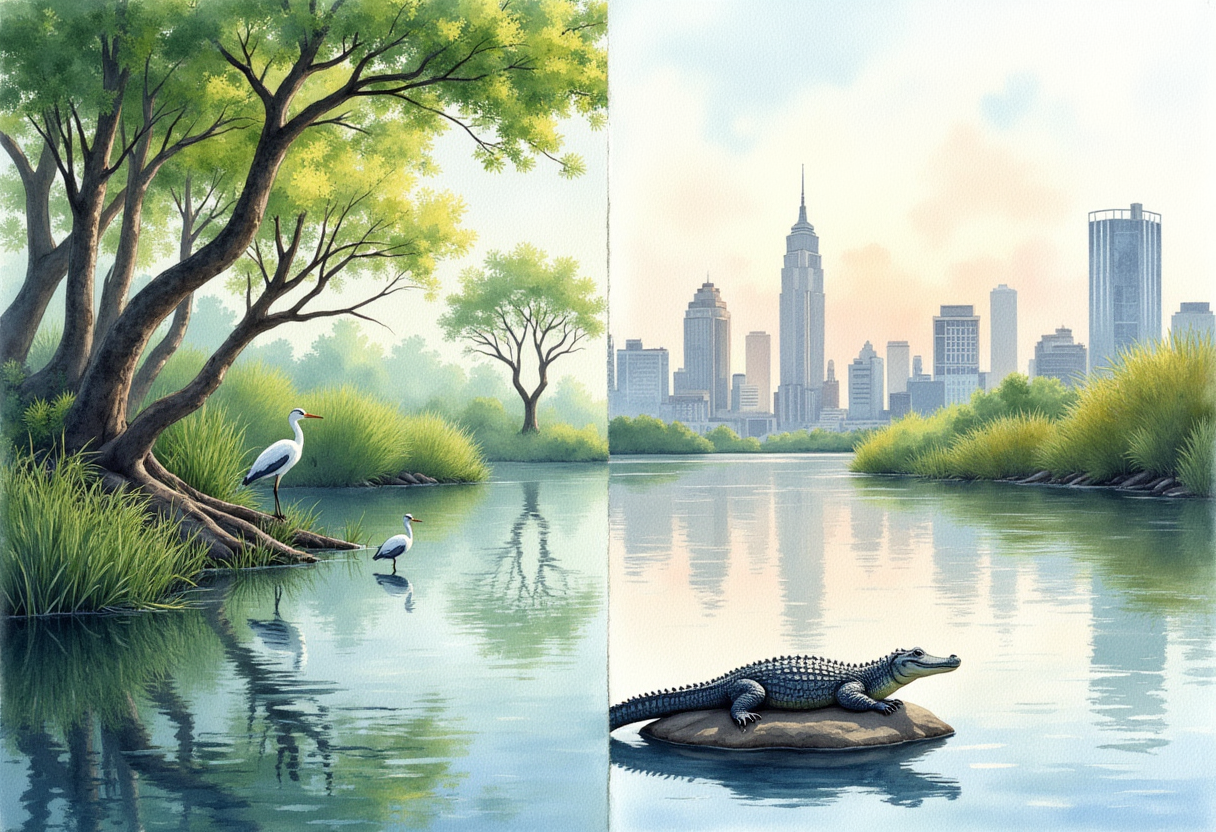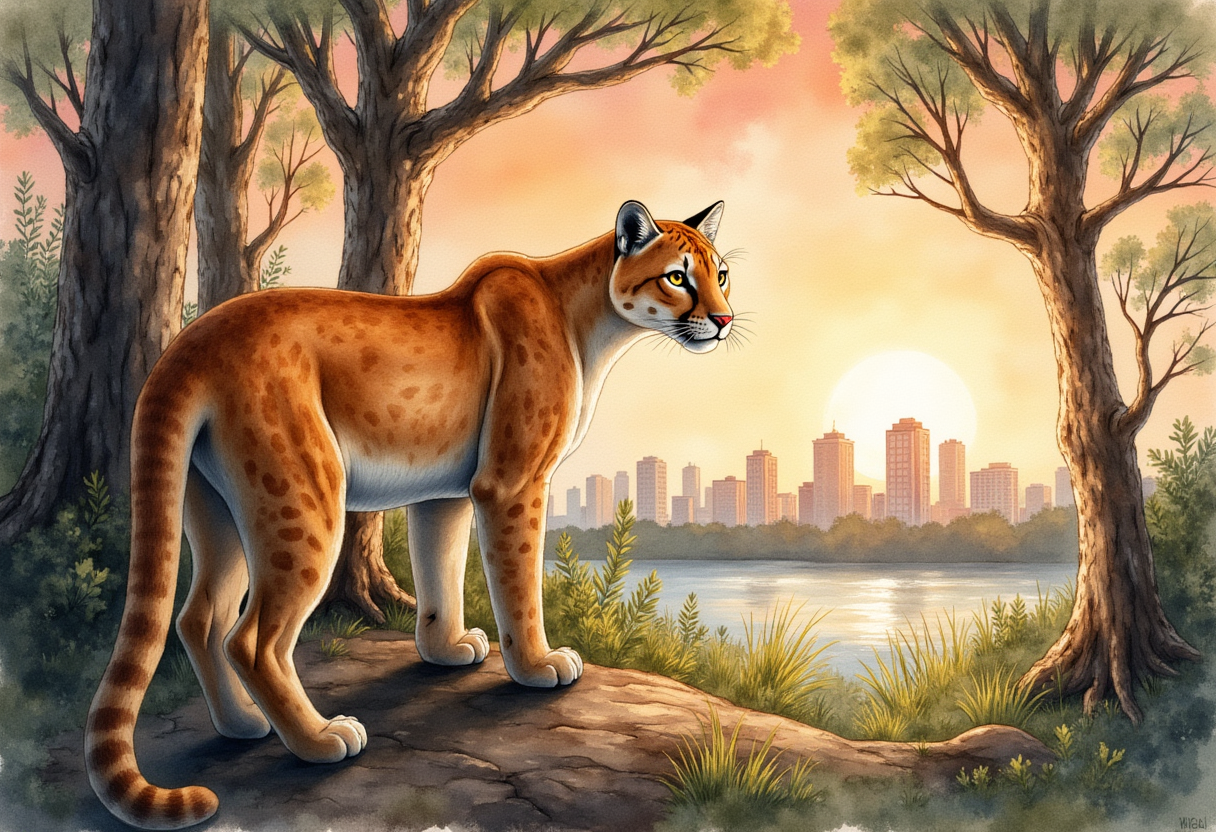Wildlife Wonders and Woes: Balancing Nature with Development
Florida — the Sunshine State — is a place of contradictions. It’s a land where ancient swamps coexist with gleaming skyscrapers, where manatees glide beneath waters that reflect luxury resorts, and where space rockets soar above fragile wetlands. The ongoing tension between wildlife and development in Florida is not new. It’s a story centuries in the making — one of ambition, adaptation, and the never-ending challenge of balancing progress with preservation.
“Split-image concept — left side lush, pristine Everglades
A Land Before Concrete: Harmony and Heritage
Long before Spanish explorers set foot on Florida’s shores, this lush peninsula was home to thriving Indigenous cultures who lived in sync with the land. The Calusa, known as the “Shell People,” built entire communities from oyster shells and thrived along the Gulf Coast’s estuaries. Meanwhile, the Timucua and later the Seminole tribes developed a deep understanding of the ecosystems they depended upon — hunting, fishing, and farming in ways that sustained rather than depleted their surroundings.
Their relationship with nature was spiritual as much as practical. Every river, tree, and animal held meaning. The alligator, for example, was not just a predator but a guardian of balance. Wetlands weren’t “wastelands” — they were life-giving systems that purified water, supported fish, and buffered against floods.
That balance began to unravel with the arrival of European colonizers. The Spanish built forts and missions, draining marshlands and introducing livestock that disrupted native ecosystems. Over the next few centuries, as settlers expanded agriculture — from citrus groves to sugar plantations — much of the natural landscape was reshaped or destroyed in the name of progress.
From Swamps to Subdivisions: The Cost of Growth
By the early 20th century, Florida was being marketed as paradise — a place where anyone could find sunshine, health, and wealth. Developers saw endless opportunity in its wetlands and forests. Unfortunately, those same wetlands were drained to make way for towns, highways, and farmland.
Few examples illustrate this transformation as dramatically as the Everglades — once spanning nearly 11,000 square miles of slow-moving “river of grass.” Massive drainage projects in the early 1900s turned much of it into agricultural land, fragmenting habitats and forever altering water flow. Today, the Everglades is only a fraction of its original size, and yet it remains one of the most biodiverse ecosystems on the planet — a testament to both its resilience and its vulnerability.
The consequences of unchecked development soon became clear. Loss of wetlands led to more frequent flooding, diminished water quality, and a decline in wildlife populations. Species like the Florida panther, wood stork, and snail kite were pushed to the brink of extinction. The manatee — once numbering in the tens of thousands — saw its population plummet due to boat strikes and habitat loss.
The Tourism Boom: Beauty Meets Exploitation
By mid-century, Florida’s transformation was unstoppable. The rise of tourism brought new prosperity but also new environmental challenges.
Theme parks like Walt Disney World and Busch Gardens drew millions of visitors each year. Coastal areas were paved over to make room for beachfront hotels, condominiums, and golf resorts. While these developments fueled economic growth, they also consumed vast tracts of land and water resources.
Ironically, much of Florida’s appeal to tourists comes from the very natural beauty that’s being compromised — its crystal-clear springs, mangrove forests, and diverse wildlife. Visitors flock to see alligators in the Everglades, dolphins in the Gulf, and flamingos in the Keys, often unaware of the pressures those environments face.
Some communities have recognized this contradiction and shifted toward eco-tourism — promoting responsible travel that supports conservation rather than undermines it. Kayaking tours through mangrove tunnels, birdwatching in wildlife refuges, and guided swamp hikes are helping people connect with nature in sustainable ways. It’s proof that tourism and preservation don’t have to be enemies; they can be allies — if done thoughtfully.
Space Age Meets Swamp Life
Another fascinating chapter in Florida’s story is how modern technology intersects with ancient ecosystems. The Kennedy Space Center and Cape Canaveral are global icons of human innovation, launching astronauts and satellites into orbit. Yet, they sit amid some of the most sensitive coastal habitats in North America.
Merritt Island National Wildlife Refuge, which surrounds NASA’s facilities, serves as a living example of coexistence. Despite its proximity to rocket launches, it remains home to over 1,500 plant and animal species, including bald eagles, manatees, and sea turtles. This unusual coexistence between cutting-edge technology and pristine wilderness raises an important question: Can we reach for the stars without losing touch with the Earth beneath our feet?
Florida’s scientists and conservationists are working to ensure the answer is yes. Environmental impact studies, habitat restoration projects, and wildlife corridors are becoming standard practices — bridging the gap between innovation and stewardship.
The New Frontier: Climate, Conservation, and Community
Today, Florida faces an even greater challenge — climate change. Rising sea levels threaten both human settlements and animal habitats. Saltwater intrusion is damaging freshwater ecosystems, and increased storm intensity puts fragile coastal zones at constant risk.
Conservation efforts are evolving to meet these threats. The Florida Wildlife Corridor Act, passed in 2021, aims to connect fragmented habitats across the state, giving animals like the panther and black bear room to roam. Local organizations are also restoring wetlands, planting native vegetation, and rehabilitating coral reefs to strengthen natural defenses against climate impacts.
Majestic Florida panther standing on the edge of a shrinking forest
Meanwhile, developers are being pushed to adopt green building standards, reduce water consumption, and integrate wildlife-friendly designs into their plans. In cities like Sarasota, Orlando, and Miami, new communities are emerging that embrace sustainability — with permeable pavements, solar power, and protected green spaces. These are hopeful signs that Florida can continue to grow without sacrificing its wild heart.
A Call to Protect Paradise
The story of Florida’s wildlife is, ultimately, a story of choices. Every road built, every resort constructed, and every acre preserved or restored represents a decision about what kind of future the state will have.
We’ve seen what happens when development goes unchecked — species vanish, floods worsen, and once-vibrant ecosystems fade away. But we’ve also seen what happens when people unite to protect the natural world — when wetlands are restored, when endangered species recover, when nature-based tourism thrives.
Florida’s wildlife wonders are more than tourist attractions; they are living treasures that define the state’s identity. The panther’s stealthy grace, the manatee’s gentle glide, the heron’s patient stillness — they remind us that Florida is still, at its core, a wild and wondrous place.
Balancing progress with preservation isn’t easy, but it’s possible. The future of the Sunshine State depends on finding that balance — ensuring that the next generation can still marvel at its beauty, not read about it in history books.
Further Reading:
The Importance of Florida’s Ecotourism – How responsible travel helps preserve Florida’s natural wonders.
From Swamps to Strawberries: Crops That Shaped the State – The fascinating evolution of Florida’s agricultural roots.
Cuban Heritage in Florida – Exploring the cultural and environmental influences that shaped the Sunshine State.
The Search for Florida’s Best Key Lime Pie – A delicious journey through the state’s sweetest traditions.
Earl Lee
Florida Unwritten


